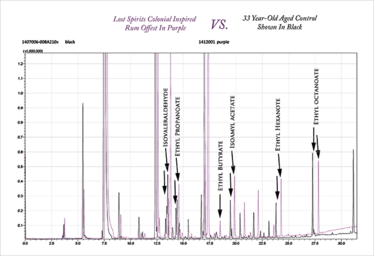The aged spirits market is a lucrative one, attracting reverence and loyalty from liquor enthusiasts in equal measure. The flavor profile of distilled spirits is enhanced by the length and method of storing – and the price tag tends to correlate with the length of time in the barrel. But Bryan Davis may have found a shortcut. Davis, founder of the Lost Spirits Distillery and described as “one of the super-stars of Mad Scientist Distillation” (1), has developed a reactor that mimics the aging effect – cutting the processing time by up to 20 years.

An offset chromatogram overlay of the Lost Spirits Colonial Inspired Rum compared against the 33 year-old control rum. Image courtesy of Bryan Davis, Lost Spirits Distillery.
The system can build spirits with the same chemical signature seen in classical aging – but with certain added advantages. “With proper tuning, it can do this without the hindrance of excess ethyl acetate build up, a ‘solventy’ aroma flaw sometimes caused as a consequence of age,” Davis says. “It can also build a slightly denser concentration of long-chained esters, responsible for the distinct finish or aftertaste found in the most prized spirits.” To gain a better understanding of the process, mass spectrometry was used to produce a chemical fingerprint of the volatile range compounds in aged rums.
Davis was responsible for designing the reactor, but the analytical work was done by a local environmental lab. “We used direct injection mass-spec on the volatile side, with the semi-volatile organics done using GC-MS,” he says. According to Davis, the chromatograms became a very useful tool at the last stage of the process for fine tuning the results: “They provided empirical evidence of the system’s efficacy in the volatile organic compound (VOC) range, but also its capability not only in building the density of semi-volatiles, but in producing a nearly identical fingerprint to 20 years in the cask (2).”
Davis, a former art teacher, says he took to chemistry “like a duck to water” despite a lack of formal education in the subject. “I never actually did high school chemistry. Our partner, a PhD chemist, did a great job of giving me a quick education in everything I needed to know about organic chemistry and booze.” But when Davis needed more information, he turned to PubMed: “I remember, for example, looking up what happens to the yeast derived ester profile of the spirit when fermentation characteristics change...”
Davis’ new chemistry knowledge and existing familiarity with the alcoholic beverage industry allowed him to find a niche area in a competitive market. “We had an absinthe lab facility that did well, but the market crashed. So we decided to leverage our relationship with the distributors,” he says. “There are already a lot of craft facilities in the US where vodkas, gins and absinthes can be made overnight, but aged products are simply not there – or aren’t very good.”
The developments have stirred up strong reactions – from disbelief to horror – and left some people shaken. “People initially asked if my work should be banned, if it was ‘fair’, or if I was undermining God’s will!” Davis says. The company has wisely avoided antagonizing certain market segments, taking a more tactical approach: “We haven’t done a Scotch whisky or a bourbon, and that’s no accident,” he says. “Bourbon and Scotch in particular are more religions than beverages!”
- rumdood.com/2014/11/30/rum-review-lost-spirits-151/
- Lost Spirits White Papers: www.lostspirits.net/#!science/nj82e
A former library manager and storyteller, I have wanted to write for magazines since I was six years old, when I used to make my own out of foolscap paper and sellotape and distribute them to my family. Since getting my MSc in Publishing, I’ve worked as a freelance writer and content creator for both digital and print, writing on subjects such as fashion, food, tourism, photography – and the history of Roman toilets.

















